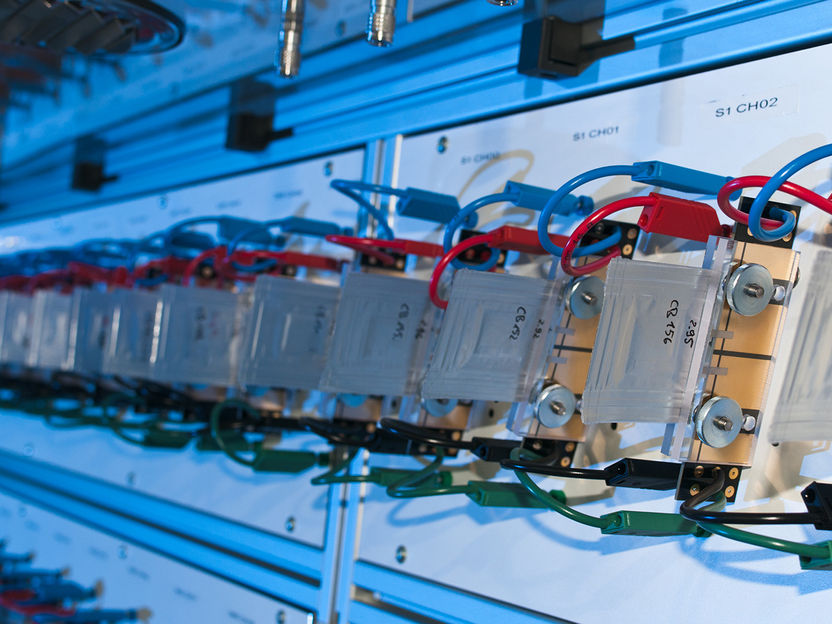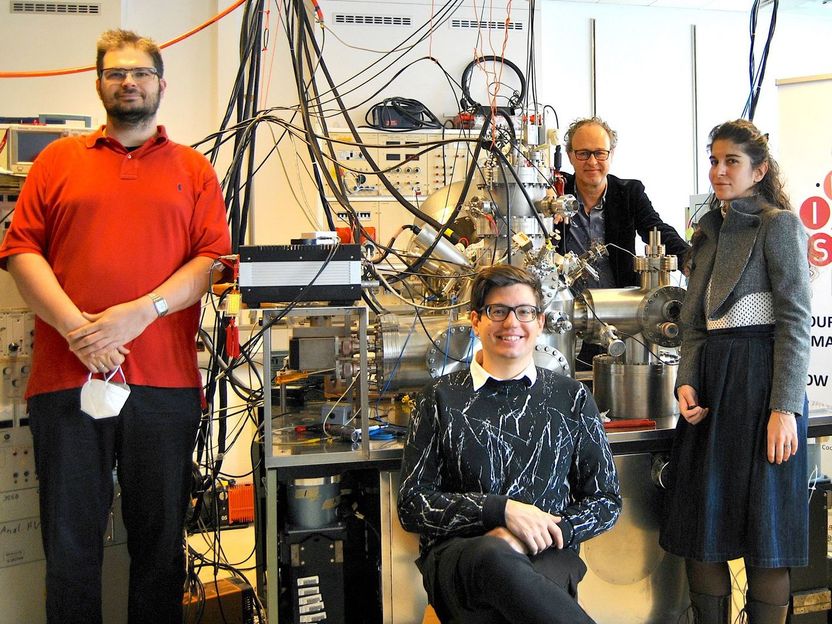With new measurement methods for a longer service life of battery cells
More sustainability in electromobility and Co
The aging of battery cells cannot be easily determined under real conditions. However, an accurate statement about the aging state of the cells in operation forms the basis for a better understanding of the aging mechanisms of a battery and for extending its lifetime. In order to be able to determine the condition of the battery cells more precisely and without laboratory effort, the determination of the AC resistance within the battery using dynamic impedance spectroscopy has been further developed at Fraunhofer IFAM in Bremen. This allows measurements to be made during operation, enabling statements to be made about performance in real time.

By measuring the so-called dynamic impedance of the battery cells the state of the battery cells during charging can be determined directly.
© Fraunhofer IFAM
Many factors are decisive for the aging of battery cells. In addition to calendar aging, which is essentially determined by storage temperatures and the state of charge during storage, the history of all charging and discharging processes with the current loads and temperatures that occurred in each case is crucial. There are therefore many varying influencing factors over long periods of time, which is why the precise determination of the aging state is complex and has so far been associated with considerable effort. In this context, existing approaches are based either on simulations, which represent a simplified description of the battery system and the decomposition process, or on experimental extrapolation of the cycle life of the battery cells. Here, the empirical relationship between the measured impedance of a cell and the capacity of the battery is determined.
Simulative modeling requires knowledge of all the necessary detailed processes for each cell type, some of which are not yet known or understood. In addition, to transfer to a new cell chemistry, the entire description process must be performed again, which in turn involves considerable effort. This is also the case with extrapolation from measurements, since here the complete measurement effort must be carried out for each cell type to be described and all existing environmental conditions (temperature, load profile, etc.). This does not even take into account more detailed descriptions like the spatial distribution of temperature within a cell.
The new development approach for determining service life gives the battery system a memory of all processes
The new approach developed at Fraunhofer IFAM consists of describing the lifetime of battery cells using a model based on a limited knowledge of cell chemistry. For this purpose, mathematical models for nonlinear behavior with "memory" effects (so-called Volterra series) are used to describe the cell properties. This approach offers the advantage that the output of the system depends on the input to the system at all times, thus the system obtains a memory of all previous processes, which is essential to describe the aging process.
The crucial step is then to measure the dynamic impedance of the battery cells during use, i.e., during charging or discharging of the cell. It is possible to directly measure the mathematical parameters describing the behavior of the cells. With the aid of this mathematical representation, states that have not been measured can then also be taken into account, enabling transferability to other ambient conditions and cell chemistries, i.e. consideration of completely new battery types.
Successful application in battery management systems
The new method not only offers the possibility of transferring the results to completely different cell types (e.g. solid-state batteries) with little effort, but above all the advantage that the measurements can be carried out directly during the use of a battery, e.g. in an electric car. Additional laboratory work or a restriction of use for age determination is therefore not necessary.
Therefore, by implementing it in the battery management system, all necessary data for lifetime prediction can be obtained at any time during the use of the system. In addition, optimized charging strategies can be developed based on this data, thus increasing the overall lifetime of the battery system. This reduces lifetime costs and increases sustainability when using a battery system in the application.
Other news from the department science

Get the chemical industry in your inbox
By submitting this form you agree that LUMITOS AG will send you the newsletter(s) selected above by email. Your data will not be passed on to third parties. Your data will be stored and processed in accordance with our data protection regulations. LUMITOS may contact you by email for the purpose of advertising or market and opinion surveys. You can revoke your consent at any time without giving reasons to LUMITOS AG, Ernst-Augustin-Str. 2, 12489 Berlin, Germany or by e-mail at revoke@lumitos.com with effect for the future. In addition, each email contains a link to unsubscribe from the corresponding newsletter.
Most read news
More news from our other portals
See the theme worlds for related content
Topic World Spectroscopy
Investigation with spectroscopy gives us unique insights into the composition and structure of materials. From UV-Vis spectroscopy to infrared and Raman spectroscopy to fluorescence and atomic absorption spectroscopy, spectroscopy offers us a wide range of analytical techniques to precisely characterize substances. Immerse yourself in the fascinating world of spectroscopy!

Topic World Spectroscopy
Investigation with spectroscopy gives us unique insights into the composition and structure of materials. From UV-Vis spectroscopy to infrared and Raman spectroscopy to fluorescence and atomic absorption spectroscopy, spectroscopy offers us a wide range of analytical techniques to precisely characterize substances. Immerse yourself in the fascinating world of spectroscopy!
Topic World Battery Technology
The topic world Battery Technology combines relevant knowledge in a unique way. Here you will find everything about suppliers and their products, webinars, white papers, catalogs and brochures.

Topic World Battery Technology
The topic world Battery Technology combines relevant knowledge in a unique way. Here you will find everything about suppliers and their products, webinars, white papers, catalogs and brochures.
Last viewed contents
First commercial use two-dimensional Fast Gas Chromatography Time-of-Flight Mass Spectrometer (Fast GC-ToF-MS) - LGC selects 4D Pegasus® III model from ATAS UK to employ state-of-the-art GC mass spectrometry capability across its business.

On the edge of friction - Precise insight into how two microscopic surfaces slide over one another could help in the manufacture of low-friction surfaces
New technique 'sees' radioactive material even after it's gone
Orlov_(diamond)

Old Mystery Solved: a "New Kind of Electrons" - Why do certain materials emit electrons with a very specific energy?
Killer silk: Making silk fibers that kill anthrax and other microbes in minutes

Putting quantum scientists in the driver's seat
Altana Pharma invests in new High Throughput Screening system from Thermo Electron




























































